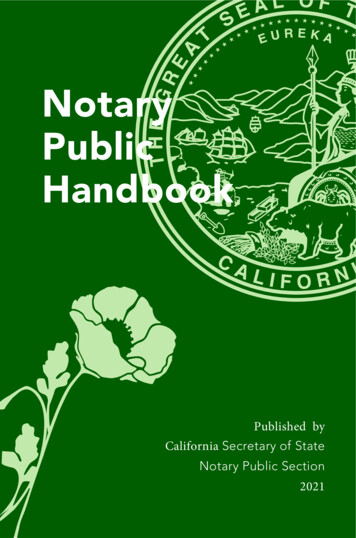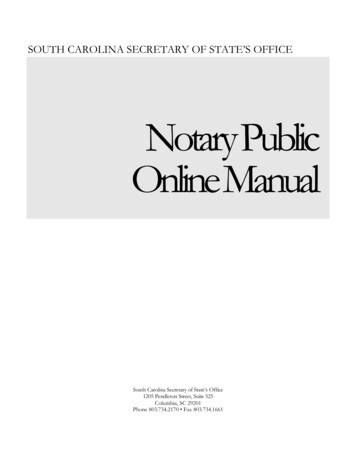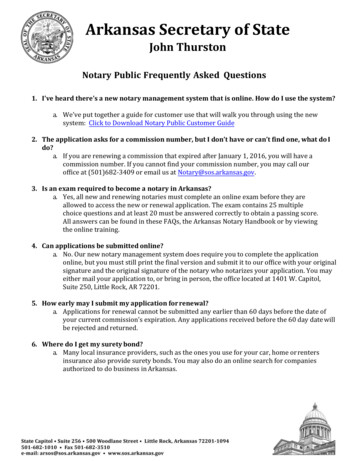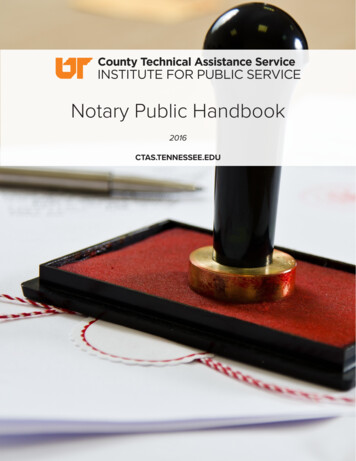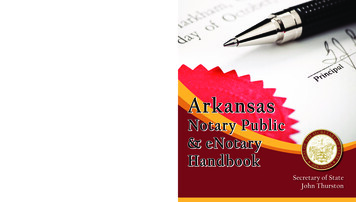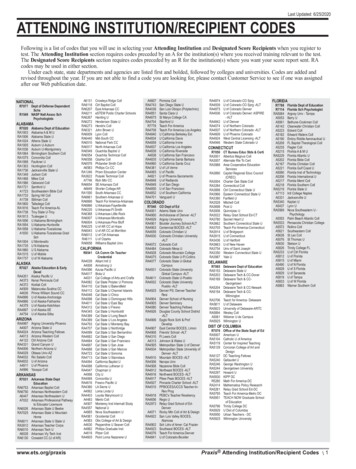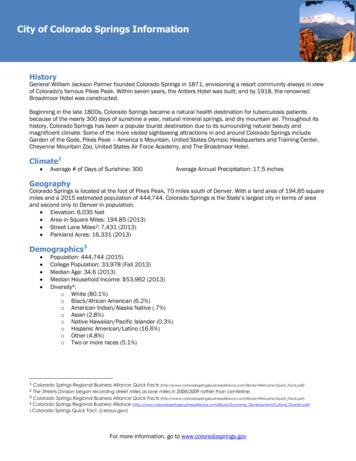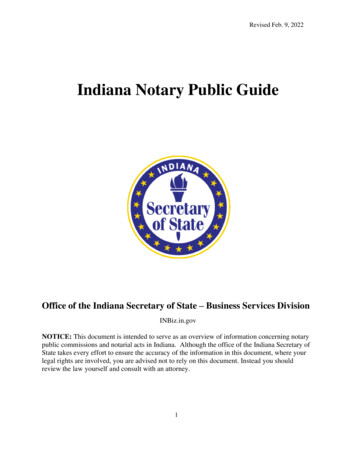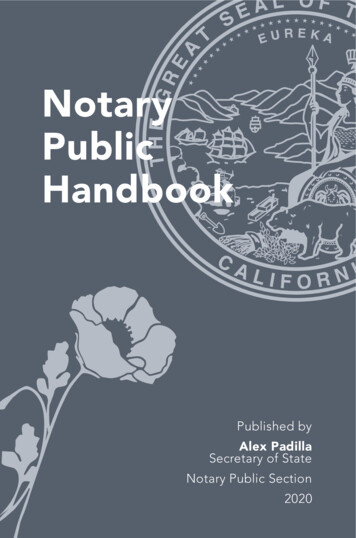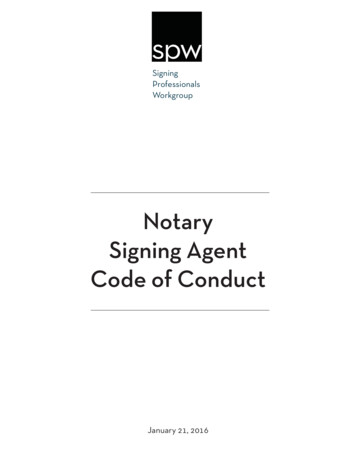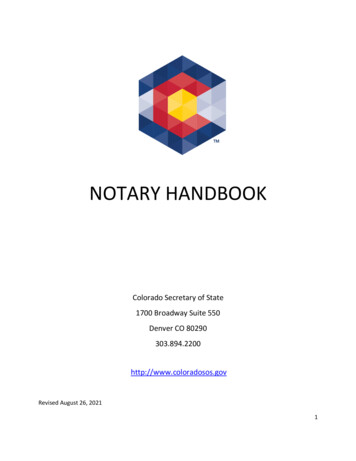
Transcription
NOTARY HANDBOOKColorado Secretary of State1700 Broadway Suite 550Denver CO 80290303.894.2200http://www.coloradosos.govRevised August 26, 20211
ContentsPURPOSE OF THE NOTARY HANDBOOK . 4WHAT IS A NOTARY? . 4WHAT ARE A NOTARY’S POWERS? . 5A NOTARY IS THE FIRST DEFENSE TO FRAUD . 5OATHS AND AFFIRMATIONS . 6SAMPLE OATHS AND AFFIRMATIONS . 8CHECKLIST UNDER RULONA . 9ACKNOWLEDGMENTS . 9CHECKLIST UNDER RULONA . 12SIGNATURE WITNESSING . 12CHECKLIST UNDER RULONA . 13OATHS AND AFFIRMATIONS VS. ACKNOWLEDGMENTS AND WITNESSING A SIGNATURE . 13COPY CERTIFICATIONS . 14CHECKLIST UNDER RULONA . 16NOTICES OF DISHONOR/PROTESTS OF NEGOTIABLE INSTRUMENTS . 16NOTARIAL CERTIFICATE OR NOTARIZATION . 17REQUIREMENTS OF A NOTARIAL CERTIFICATE . 17Official Stamp . 18Commission Expiration Date . 19Official Signature . 20NOTARY JOURNAL. 21JOURNAL REQUIREMENTS. 22DUTIES OF JOURNAL KEEPING . 23JOURNAL RETENTION. 23WHAT RECORDS MUST A NOTARY MAINTAIN WITH THE SECRETARY OF STATE? . 24WHAT DOES THE NOTARY LAW PROHIBIT? . 25CONSEQUENCES OF VIOLATING THE NOTARY LAW . 28ELECTRONIC NOTARIZATION . 29E-NOTARIZATION BASICS . 29ELECTRONIC SIGNATURES . 29USE OF A JOURNAL . 30REMOTE NOTARIZATION . 30ELECTRONIC NOTARIZATION VS. REMOTE NOTARIZATION . 31WHAT TYPES OF DOCUMENTS MAY BE REMOTELY NOTARIZED? . 32REAL-TIME AUDIO-VIDEO . 322
REMOTE NOTARIZATION RECORDING . 33JOURNAL. 35NOTARIAL CERTIFICATE . 35NOTARY SEAL . 36NOTARY SIGNATURE. 36FEES. 37GENERAL INFORMATION. 37APPENDICES . 38APPENDIX A . 39SAMPLE NOTARIAL CERTIFICATES . 39APPENDIX B . 42CREDIBLE WITNESS GUIDE. 42SAMPLE CREDIBLE WITNESS STATEMENT. 44APPENDIX C. 45SAMPLE ENOTARIZATION . 45APPENDIX D . 46SAMPLE REMOTE NOTARIZATION NOTARIAL CERTIFICATE . 46APPENDIX E . 47ADDITIONAL RESOURCES . 47Revised Uniform Law on Notarial Acts (RULONA) . 47Colorado Notary Rules . 47APPENDIX F . 48CHECKLISTS . 48Oath and Affirmations Checklist . 48Acknowledgment Checklist. 48Signature Witness Checklist . 49Copy Certification Checklist . 49Remote Notarization Checklists. 50APPENDIX G . 52SECRETARY OF STATE CONTACT INFORMATION . 52GLOSSARY . 53INDEX . 573
Purpose of the Notary HandbookAs a notary public, you hold an important position; therefore, it is vital that you understand the notary dutiesand responsibilities with which you have been charged. The purpose of this handbook is to help familiarizeyou with Colorado Notary Law so that you can perform your duties correctly.Notaries public are authorized to perform certain official duties that are critical to those who need them. Bynotarizing documents, you help to prevent fraud and forgery. Because the work of notaries public is soimportant, please make sure you take the time to review this guide carefully. It is critical for you tounderstand the obligations of being a notary public and for you to perform those duties in a manner thatmerits the trust, confidence, and respect appropriate to the office.Please note that this handbook is merely a guide to best practices, but the Revised Uniform Law on NotarialActs (RULONA) is the law on which the handbook is based. Accordingly, all incongruities between thehandbook and the statute will be decided in favor of the statute (C.R.S. 24-21-501 et seq.) Notaries areresponsible for keeping themselves apprised of changes in the law that may affect the manner in which theyperform notarizations.The Colorado notary law and other resources for notaries are available on the Notary Home page of theSecretary of State’s website: at is a Notary?“Notary” or “Notary Public” means an individual appointed and commissioned to perform a notarial act bythe Secretary of State (C.R.S. 24-21-502(8)). A “Notarial Officer” means a notary public or other individualauthorized to perform a notarial act (C.R.S. 24-21-502(7)). Because the definition in the Colorado RevisedStatutes is so brief, the following information has been included to further describe a Notary.Various definitions/synonyms for “notary public” can be drawn from other states’ statutes. The followinglist is representative rather than all-inclusive.4
A notary is a: Verifier Authenticator Person of integrity appointed to the office Person commissioned to stamp documents Impartial agent for the state Public recorder of acts Public servantThe notary acts as an unbiased/disinterested/official WITNESS, to the identity of the person whosigns a document.In this context, while notarizing, a notary is responsible not to a customer or a supervisor, but to thepeople of the State of Colorado through the Secretary of State, the elected representative of thosepeople.What are a Notary’s Powers?Notary powers are equivalent to duties.Under RULONA, Colorado notaries have four common powers. RULONA (C.R.S. 24-21-505) lists the notarypowers/duties under five subsections. The four main powers that the notary will be exercising are (1)acknowledgments, (2) the administration of oaths and affirmations, (3) copy certifications, and (4) witnessor attest to signatures.Under RULONA, there is a fifth power referred to as making or noting a protest of a negotiable instrument,but it is only bestowed upon notaries who are employed by a financial institution, and who are acting in thecourse and scope of that employment. Nevertheless, a discussion of this power is included below.A notary is the first defense to fraud5
Regardless of which notarial act, or duty, a notary is performing, the notary has a duty to check that his/herclient has basic comprehension of the document being signed.If a client is, for example, obviously drunk or drugged or otherwise disoriented, or too ill to communicate orknow what is happening, or too young to understand the transaction at all, a notary should not perform thenotarization. Such a client cannot meaningfully acknowledge a document or execute it as his/her own actand deed. Please note, while it is the ethical duty of the notary to make sure the client is capable ofunderstanding what s/he is signing, it is not a duty that is codified in law.This assessment can be made in the course of a brief discussion of the transaction, by asking the client aboutthe transaction, or just by asking if the client understands what the document is and whether s/he agreeswith it.Unless the notary is an attorney, it is never the place of the notary to counsel or advise the client aboutthe transaction, or attempt to convey the legal implications of a document presented for notarization, orexplain a transaction or its effects on a client. A notary who attempts to do so exceeds his/her lawful powersand takes on liabilities s/he should not and need not have by engaging in the unauthorized practice of law.Oaths and AffirmationsThese notarizations all require the exercise of the notary’s power to administer oaths. (C.R.S. 24-21-505).“Oaths,” as used herein, is intended to include affirmations. There is a minor difference, however. An oathis defined as a vow, promise, pledge or solemn declaration that refers to a supreme being—e.g., “This is thetruth, the whole truth, and nothing but the truth, so help me God” or “I swear to God.” Whereas anaffirmation does not include the word “swear” nor invoke a deity—e.g., “I solemnly affirm” or “I affirm underpenalty of perjury.”The power to administer oaths is the one most used by the majority of notaries. It is the power required tobe exercised every time a notary completes the common “Subscribed and sworn to” notarization.It's important for notaries to learn what “subscribed and sworn to” means for several reasons: In order to comply with the law (C.R.S. 24-21-505) and avoid violations, Because businesses, individuals, and governments depend on the notary’s knowledge andproper performance,6
For protection of both notary and client, primarily by placing responsibility for the truth ofthe document on the client, where it belongs.RULONA distinguished between an oral oath, or affirmation, and one made in written record. In a writtenrecord, it is called a “verification on oath or affirmation,” or “verification of a statement on oath oraffirmation.” The requirements for performing them are the same as an oral oath, or affirmation. All oathsand affirmations, even those that are only given orally, must be recorded in the notary’s journal.To perform the oath/affirmation process, the notary must:1. Hear the client affirm or swear to the document, to his/her identity as the document signer (andrarely, to other facts about himself or herself that a document may require. The affirmation in theNotary Application (C.R.S. 24-21-521(5)) is an example of such “other facts” that may have to besworn/affirmed—the applicant must state “under penalty of perjury” that he has read the notarylaw and will act in accord with it.)2. See the client sign the document; and3. Complete the notarial certificate or “notarization.”REMEMBER: the signer must be in your physical presence for all three of the above steps.Many notaries miss important steps within the process. They watch the signing and fill out the notarialcertificate, but omit the most important part of a jurat, the administration of the oath or affirmation. In thatcase, a client may sign a document without even being aware that s/he is supposedly swearing to it. Theclient may not even have read the document thoroughly, much less have been prepared to affirm to it underpenalty of perjury.Such a client may complain about the notary’s improper performance later and the Secretary of State willbe forced to investigate the matter. After all, the notary is a public officer who has “carefully read the notarylaw of this state” and has solemnly undertaken to perform all notarizations in conformance with that law(C.R.S. 24-21-521(5)).Read the bottom of the document and see if the notarial certificate states “subscribed and sworn to” or“affirmed before me” or “attested this day” or any similar words, as this would indicate an oath oraffirmation is required. If an oath or affirmation is required, do not simply watch the client sign and then fill7
in the notarial certificate; put the client under oath and have him/her swear to, or affirm, both the documentand his/her identity.How do you do this? The notary law gives notaries the power to administer oaths and affirmations (C.R.S.24-21-505(2)), but it does not give notaries any specific instructions or wording for this purpose. For thisreason, a notary should adopt wording for jurats that is understandable to both the notary and the client,and should use it consistently. Some samples of wording are listed below.Sample Oaths and AffirmationsFor an oath, substitute the word “swear” for the word “affirm” and add “so help you God” to the end of thestatement. Do you affirm (swear) under penalty of perjury that you are (Name of individual swearingor affirming) and that what you are about to say is true (so help you God)? Do you affirm (swear) under penalty of perjury that you are (Name of individual swearingor affirming) and that you have read and understand (document name) andthat to the best of your knowledge and belief it is true (so help you God)? Do you affirm (swear) under penalty of perjury that you are (Name of individual swearingor affirming) and that you have executed this (insert type of document executed)and that it is your free act and deed (so help you God)?Notice that in each example above, it is the signer that is attesting to the truthfulness of his/her statements,to the fact that s/he is signing of his/her own accord, and that s/he has the legal capacity to make suchstatements.It is NEVER the job of the notary to make these statements in his/her notarial certificate, or to come tothese conclusions on his/her own. The notary is just there to witness these statements and to take thestatements under oath or affirmation. A notary who makes statements like, “In my opinion the personbefore me is signing under his own free will,” or “the person before me has the proper legal capacity tosign this document,” is engaging in the unauthorized practice of law.The unauthorized practice of law is illegal and may carry criminal penalties like jail time and civil penaltieslike owing money. (Please review C.R.S. 24-21-524 for a list of prohibited acts and the consequences if anotary performs them.)8
Checklist under RULONAYou may use the below checklist to help you remember all the requirements of administering an oath oraffirmation.AcknowledgmentsA notary also has the power to witness and certify certain unsworn statements and declarations. Thesenotarizations require the exercise of the notary’s power to take acknowledgments. (C.R.S. 24-21-505).The power to take acknowledgments is less used by notaries who have a general practice, but is virtually theonly power used by those who specialize in closings and other real estate transactions. If you have ever beeninvolved in buying or selling a house, it is likely that you are already familiar with the concept ofacknowledgments.Acknowledgments do not involve any oath or affirmation. They do not say “subscribed and sworn to” or“affirmed” or make any other reference to an oath. Instead, they say “acknowledged before me” or at leastcontain the word “acknowledged” somewhere in the notarization.Upon seeing that word, a notary should know that s/he will not be administering an oath, but will be carryingout another duty instead, before signing and stamping the document. There are three steps to complete anacknowledgment.The notary must:9
First: Identify the client as the document signer. The client will not be taking an oath as to his/her identity,so this is entirely the notary’s responsibility to verify the identity. A wise notary identifies all signers carefully,no matter what notarial duty is performed, but acknowledgments call for special attention in this respect.RULONA, (C.R.S. 24-21-507), expands and clarifies the types of identification that provide satisfactoryevidence, and creates different categories:1. These documents are always satisfactory evidence: a passport, driver’s license, or government issuednon-driver identification card that is current or expired not more than one year. This list also includesforeign passports and foreign driver’s licenses.2. Other forms of government-issued IDs that are current or expired not more than one year may beacceptable if:a. They contain the signature OR photograph of the individual; ANDb. They are satisfactory to the notary. This provision gives the notary some discretion to acceptforms of identification such as jail IDs issued by counties and other types of ID issued byforeign governments, but only if the notary is satisfied that the ID is legitimate and properlyidentifies the individual.3. A notary may identify an individual through the sworn statement of a credible witness. The witnessmust provide a verification on oath or affirmation as to the person’s identity. In addition, the witnesscan be identified by the notary either through personal knowledge OR on the basis of a passport,driver’s license, or government-issued non-driver identification card that is current or expired notmore than one year. For a guide, please see Appendix B.4. A notary may use his/her personal knowledge to identify an individual. A notary has “personalknowledge” of an individual’s identity if “the individual is personally known to the officer throughdealings sufficient to provide reasonable certainty that the individual has the identity claimed.” Inother words, the notary may know the individual because they are neighbors, coworkers, or havedone business together in the past.For some acknowledgments, client identification may have a second part. A signer may be acknowledging ina representative capacity. In such cases, the notary should identify the individual AND his or her capacity.The signer should attest to his capacity/or legal authority. It is not up to the notary to research theirauthority, make an ultimate determination, or to draw any legal conclusions. To do so is considered theunauthorized practice of law.10
Second: Assess the client’s basic competence and understanding of the document. Again, a wise notary doesnot do any type of notarization for a client who is obviously not competent. However, a notary has a littlemore responsibility for this assessment on acknowledgments than on other types of notarizations.Third: Be satisfied that the client is not under duress or being coerced to make the acknowledgment.Acknowledgments must be voluntary. They must be the “free will acts and deeds” of the client. For thisreason, a notary who sees evidence of duress or coercion used to extract an acknowledgment from a clientshould not proceed with the notarization until and unless the duress issues are resolved to the notary’ssatisfaction.Every notary should be prepared to handle such a situation. Duress questions are never easy, but they arevery difficult indeed when they come as a complete surprise to the notary.If a duress issue arises, how should a notary handle it?First, a notary should evaluate the situation. A notary should be sure s/he is dealing with a genuine duressquestion. Not everything that looks like coercion at first glance is an interference with a client’s “free will actand deed.”Example: Client is before the notary to sign over his share in the family home to his soon-to-be-ex-wife. Hecomplains bitterly that he does not wish to do so, but has been forced to by an “unjust court system thatalways sides with the woman.” In this example, the client is not under duress. Being forced to sign adocument under court order is not considered duress.Here is a more difficult example: A notary is notarizing for a real estate transaction. The clients are spouseswho are getting a second mortgage on their house. The wife appears a little before the time for the closingand the notary assembles the documents, sits down with the wife, and asks her about the transaction. Thewife appears to understand the transaction perfectly well, but volunteers the information that she doesn’twant to engage in it. It is all her husband’s idea. She is reluctant to argue with him, however, because—although he is the perfect husband 99% of the time—once in a while he gets drunk and turns violent. Atthose times, he is likely to recall any resistance she has shown him and literally beat her up for it. She tellsthe notary that it is safer and easier for her just to go through with the transaction. When the notary seemshesitant, the wife tells the notary to forget she said anything about her husband’s violent tendencies, andasks the notary not to mention their conversation to the husband when he shows up.Is it proper for the notary to take the wife’s acknowledgment? This would be up to the notary’s discretion.The individual notary’s professional judgment governs in every specific case, and the notary has the right11
to “refuse to perform a notarial act if the officer is not satisfied that (a) the individual executing the recordis competent or has the capacity to execute the record; or (b) the individual’s signature is knowingly andvoluntarily made.” (C.R.S. 24-21-508).A notary may ask for help in difficult situations, but, in the end, the notary’s decision governs as to whethera client is adequately identified and sufficiently competent and willing to make an acknowledgment. Anotary is expected to be a disinterested witness, not an intruder into the transaction. S/he is to be a neutralobserver, exercising only the judgment of an “ordinary and prudent person.” A notary is not a doctor, advisor,law enforcement officer, etc. However, if a notary suspects potential fraud or abuse, especially elder abuseor elder financial exploitation, the notary should report the abuse to local law enforcement.Once the notary has completed the tasks above, all that is left is to perform the acknowledgment.Checklist under RULONAYou may use the below checklist to help you remember all the requirements of taking an acknowledgment.Signature WitnessingRULONA distinguishes between taking an acknowledgment – where a person has already signed the recordand is acknowledging their signature to the notary- and witnessing a signature.12
The functional requirements to identify the signer, ensure that they are the person named in the record,and verify the signature is theirs, remain the same. However, RULONA provides a separate short-formcertificate for signature witnessing.Checklist under RULONAYou may use the below checklist to help you remember all the requirements of witnessing a signature.Oaths and Affirmations vs. Acknowledgments and Witnessinga SignatureAdministering oaths and affirmations, taking acknowledgments, and witnessing signatures are mostnotaries’ main duties. Many people lump them together, but there are differences between them. The mostobvious is the oath itself.In a jurat (for an oath or affirmation), you, the notary,
Under RULONA, Colorado notaries have four common powers. RULONA (C.R.S. 24-21-505) lists the notary powers/duties under five subsections. The four main powers that the notary will be exercising are (1) acknowledgments, (2) the administration of oaths and affirmations, (3) copy certifications, and (4) witness or attest to signatures.
